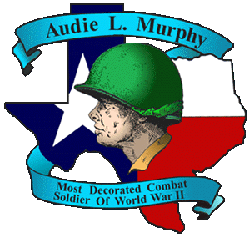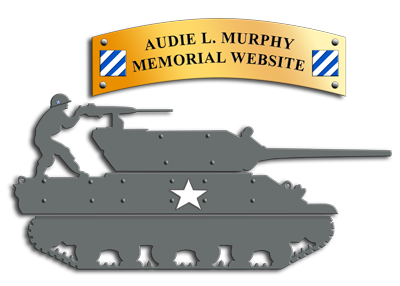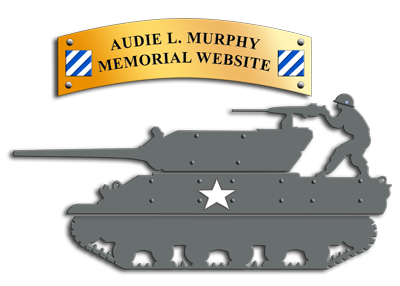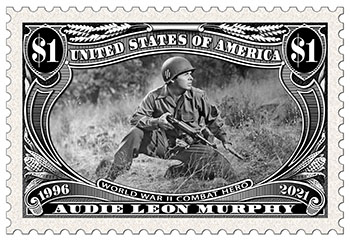
|
| Image source: Audie Murphy: American Soldier
written by Harold B. Simpson . |
Audie Leon Murphy, born June 20, 1925*, son of poor Texas sharecroppers, rose to national fame as the most decorated U.S. combat soldier of World War II. Among his 33 awards and decorations was the Medal of Honor, the highest military award for bravery that can be given to any individual in the United States of America, for "conspicuous gallantry and intrepidity at the risk of his life above and beyond the call of duty." He also received every decoration for valor that his country had to offer, some of them more than once, including 5 decorations by France and Belgium. Credited with either killing over 240 of the enemy while wounding and capturing many others, he became a legend within the 3rd Infantry Division. Beginning his service as an Army Private, Audie quickly rose to the enlisted rank of Staff Sergeant, was given a "battle field" commission as 2nd Lieutenant, was wounded three times, fought in 9 major campaigns across the European Theater, and survived the war.
During Murphy's 3 years active service as a combat soldier in World War II, Audie became one of the best fighting combat soldiers of this or any other century. What Audie accomplished during this period is most significant and probably will never be repeated by another soldier, given today's high-tech type of warfare. The U.S. Army has always declared that there will never be another Audie Murphy.
On 21 September, 1945, Audie was released from the Army as an active member and reassigned to inactive status. During this same time, actor James Cagney invited Murphy to Hollywood in September 1945, when he saw Murphy's photo on the cover of Life Magazine. The next couple of years in California were hard times for Audie Murphy. Struggling and becoming disillusioned from lack of work while sleeping in a local gymnasium, he finally received token acting parts in his first two films.
His first starring role came in a 1949 released film by Allied Artists called, Bad Boy. In 1950 Murphy eventually got a contract with Universal-International (later called Universal) where he starred in 26 films, 23 of them westerns over the next 15 years. His 1949 autobiography To Hell And Back was a best seller. Murphy starred as himself in a film biography released by Universal-International in 1955 with the same title. The movie, To Hell and Back, held the record as Universal's highest grossing picture until 1975 when it was finally surpassed by the movie Jaws. In the mid-60s the studios switched from contract players to hiring actors on a picture-by-picture basis. Consequently, when his contract expired in 1965 Universal did not renew. This gave him the opportunity to work with other studios and independent film producers. In the 25 years that Audie spent in Hollywood, he made a total of 44 feature films.
Audie also filmed a 26 episode western television series, known as Whispering Smith which aired on NBC in 1961. Although the series earned good reviews, it was also characterized as unusually violent. Only 20 episodes were aired before the series was cancelled.
Despite his success in Hollywood, Audie never forgot his rural Texas roots. He returned frequently to the Dallas area where he owned a small ranch for a while. He also had ranches in Perris, California and near Tucson, Arizona. He was a successful Thoroughbred and Quarter Horse racehorse owner and breeder, having interests in such great horses as "Depth Charge." His films earned him close to 3 million dollars in 23 years as an actor. Audie loved to gamble, and he bet on horses and different sporting events. He was also a great poker player. In his role as a prodigious gambler, he won and lost fortunes.
Audie Murphy wrote some poetry and was quite successful as a songwriter. He usually teamed up with talented artists and composers such as Guy Mitchell, Jimmy Bryant, Scott Turner, Coy Ziegler, or Terri Eddleman. Dozens of Audie Murphy's songs were recorded and released by such great performers as Dean Martin, Eddy Arnold, Charley Pride, Jimmy Bryant, Porter Waggoner, Jerry Wallace, Roy Clark, Harry Nilsson and many, many others. His two biggest hits were Shutters and Boards and When the Wind Blows in Chicago. Eddy Arnold recorded When the Wind Blows in Chicago for his 1993 album Last of the Love Song Singers which is currently in release by RCA.
Audie sufferred from what is now known as Post Traumatic Stress Disorder (PTSD)and was plagued by insomnia and depression. During the mid-60's he became dependent for a time on doctor prescribed sleeping pills called Placidyl. When he recognized that he had become addicted to this prescription drug, he locked himself in a motel room, stopped taking the sleeping pills and went through withdrawal symptoms for a week.
Always an advocate for the needs of veterans, he broke the taboo about discussing war related mental problems after this experience. In a effort to draw attention to the problems of returning Korean and Vietnam War veterans, Audie Murphy spoke-out candidly about his personal problems with PTSD, then known as "Battle Fatigue". He publicly called for United States government to give more consideration and study to the emotional impact war has on veterans and to extend health care benefits to address PTSD and other mental health problems of returning war vets.
While on a business trip on May 28, 1971, (Memorial Day Weekend) he was killed at the age of 45*. A private plane flying in fog and rain crashed in the side of a mountain near Roanoke, Virginia. Five others including the pilot were also killed. Although Audie owned and flew his own plane earlier in his career at Hollywood, he was among the passengers that tragic day.
At the time of his death, Audie Murphy was only given a combined total of 1 minute and 30 seconds of news time by the major television news networks ABC, CBS, and NBC. On October 29, 2013 news affiliates of the same major networks would devote nearly 2 minutes each to Audie Murphy when Governor Rick Perry posthumously presented the Texas Legislative Medal of Honor to Audie Murphy.
On June 7th, Audie Murphy was buried with full military honors in Arlington National Cemetery. His gravesite, near the Amphitheater, is second most visited gravesite year round. President Kennedy's grave is the most visited.
In 1996 the Texas Legislature officially designated his birthday, June 20th, as Audie Murphy Day. On June 9, 1999 Governor George W. Bush, Texas made a similar proclation declaring June 20th to officially be Audie Murphy Day in the state of Texas. On October 29, 2013, Governor Rick Perry posthumously awarded the Texas Legislative Medal of Honor in Farmersville, Texas to Audie Murphy by presenting it to his only surviving sibling, Nadine Murphy in a ceremony held in Farmersville, Texas.
*Note on Birthyear: Audie Murphy was born June 20, 1925 and was seventeen when he enlisted. Many sources incorrectly state he was born June 20, 1924. The error is based on confusion created by a falsified birth certificate Audie Murphy filed at the Hunt County, Texas Courthouse, with the help of his older sister, Corrine, so he could join the military before he was legally of age. Audie later admitted, on more than one occasion, that he lied about his age. References corroborating this fact include documents and interviews where Audie admits falsifying his birthday:
(1) Audie's 1970 California Driver's license
(2) Photoplay, January 1951, page 80;
(3) Modern Screen, July 1951, page 70;
(4) Modern Screen, July 1955, page 85;
(5) Movie Stars Parade, January 1958, page 68;
(6) "The War Hero" by Thomas B. Morgan, Esquire magazine, Vol. 100, No. 6, December 1983 (pages 597-604);
(7) "Helmets in the Dust" by David McClure, circa 1956, based on about 80 pages of writings by Audie Murphy and conversations held between McClure and Murphy states that Audie Murphy joined the Army on his seventeenth birthday, having falsified his age to be eligible for enlistment; and
(8) Movie Stars Parade, February 1951, page 85
Upgrading Audie Murphy's Family Tree
by Richard Rodgers
|
|
In 2020 Audie Murphy's family tree was upgraded to include recently uncovered information. The revised family tree has significant details for 3 major genealogical family branches: the Murphy, Killian, and Lunsford branches which stretch back to the 16th, 15th, and 8th centuries respectively. Genealogists helping providing information to this revision include Gary Murphy - a Murphy Family historian and Bill Allen from the Dockery Family Reunion Association. Read the related article and see this revised family genealogy by using the button below.
|
|
|
|
|
|

|
|
|







